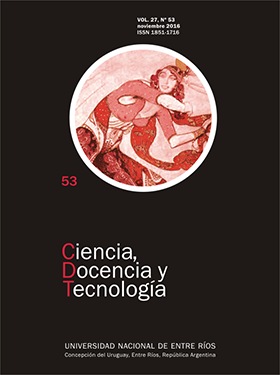Abstract
Se emplea como elemento de reflexión, las pruebas estatales de egreso de la educación secundaria y cuál sería la posible influencia de éstas en los posteriores desempeños universitarios de los estudiantes. Inicialmente, se realiza un barrido sobre algunas pruebas existentes a nivel mundial y algunos estudios que han intentado atribuir cierto nivel de influencia a estos resultados. Posteriormente, se presenta una propuesta metodológica que intenta describir las condiciones de entrada de los estudiantes que ingresaron a una universidad colombiana en un periodo de tiempo, y a través de un análisis longitudinal observar su progreso académico. Este seguimiento se realiza teniendo en cuenta una medida intuitiva del rendimiento en las asignaturas que se relacionan directamente con las componentes asociadas a matemáticas y lenguaje. De esta manera, se determinan asociaciones entre los desempeños en pruebas de Estado y los posteriores rendimientos académicos, siendo este último un análisis a través del tiempo.
References
ARDILA, A. (2001). Predictors of university academic performance in Colombia, en: International Journal of Educational Research, 35(4), 411-417.
BARON, J.; NORMAN, M. F. (1992). SATs, achievement tests, and high-school class rank as predictors of college performance, en: Educational and Psychological Measurement, 52(4), 1047-1055.
BECERRA GONZÁLEZ, C. E.; RIDL MARTÍNEZ, L. M. (2015). Motivación, autoeficacia, estilo atribucional y rendimiento escolar de estudiantes de bachillerato, en: Revista Electrónica de Investigación Educativa, 17(3), 79-93.
BOUREL, M.; DÍAZ, J.; LACUÉS, E.; RABÍN, F.; SABATTINO, J. Algunas cuestiones para pensar sobre el ingreso de los estudiantes a las carreras de ingeniería en Uruguay. En: VII Congreso Iberoamericano de Educación Matemática – CIBEM (16 – 20 de septiembre de 2013). Sociedad de Educación Matemática Uruguaya, Uruguay.
BRAUN, S.; DWENGER, N. (2009). Sucess in the university admission process in Germany: regional provenance matters, en: Higher Education, 58(1), 71-80.
BRIDGEMAN, B.; McCAMLEY-JENKINS, L.; ERVIN, N. (2000). Predictions of freshman grade-point average from the revised and recentered SAT I: reasoning test (College Board Report No. 2000-1). The College Board. Disponible en: < http://research.collegeboard.org/sites/default/files/publications/2012/7/researchreport-2000-1-predictions-freshman-gpa-revised-recentered-sat-reasoning.pdf > [4 de febrero de 2016].
CAMARA, W. J. (2001). There is no mystery when it comes to the SAT I. New York: The College Board.
CARVAJAL, P.; MOSQUERA, J. L.; ARTAMONOVA, I. (2009). Modelos de predicción del rendimiento académico en Matemáticas I en la Universidad Tecnológica de Pereira, en: Scientia Et Technica, 3(43), 258-263.
CENTRO DE ESTUDIOS DE LA EDUCACIÓN ARGENTINA - CEA. (2014). Universidad: ¿hacen falta exámenes de ingreso? Universidad de Belgrano. Disponible en: < http://www.ub.edu.ar/centros_de_estudio/cea/cea_numero_18.pdf > [16 de enero de 2016].
CHAPARRO CASO LÓPEZ, A. A.; GONZÁLEZ BARBERA, C.; CASO NIEBLA, J. (2016). Familia y rendimiento académico: configuración de perfiles estudiantiles en secundaria, en: Revista Electrónica de Investigación Educativa, 18(1), 53-68.
CLERICI, C.; MONTEVERDE, A. C.; FERNÁNDEZ, A. (2015). Lectura, escritura y rendimiento académico en ingresantes universitarios, en: Ciencia, Docencia y Tecnología, 26(50), 35-70.
CLINEDINST, M. E.; HAWKINS, D. A. (2010). 2010 state of college admission. National Association for College Admission Counseling. Disponible en: < http://www.nacacnet.org/research/publicationsresources/marketplace/documents/soca2010.pdf > [30 de enero de 2016].
COHN, E.; COHN, S.; BALCH, D.; BRADLEY, J. (2004). Determinants of undergraduate GPAs: SAT scores, high-school GPA and high-school rank, en: Economics of Education Review, 23(6), 577-586.
COYLE, T. R.; PILLOW, D. R. (2008). SAT and ACT predict college GPA after removing "g", en: Intelligence, 36(6), 719-729.
DUBUC, M. (2014). Influence des facteurs physiologiques et des habitudes de vie sur le rendement scolaire des étudiantes universitaires de premier cycle (thèse de maitrise non publiée). Québec: Université du Québec à Montréal.
KOBRIN, J. L. ; PATTERSON, B. F.; SHAW, E. J.; MATTERN, K. D. ; BARBUTI, S. M. (2008). Research Report No. 2008-5. Validity of the SAT for predicting first-year college grade point average. The College Board. Disponible en: < https://professionals.collegeboard.com/profdownload/Validity_of_the_SAT_for_Predicting_First_Year_College_Grade_Point_Average.pdf > [4 de febrero de 2016].
LENNING, O. T. (1975). Predictive validity of the ACT tests at selective colleges. The American College Testing Program. Disponible en: < https://www.act.org/research/researchers/reports/pdf/ACT_RR69.pdf > [12 de diciembre de 2015].
NOBLE, J. (2000). ACT Research Report Series 2000-9. Effects of differential prediction in college admissions for traditional and nontraditional-aged students. ACT. Disponible en: < https://www.act.org/research/researchers/reports/pdf/ACT_RR2000-9.pdf > [22 de diciembre de 2015].
RANSDELL, S.; HAWKINS, C.; ADAMS, R. (2001). Predicting academic performance of college students in the United States and in Estonia, en: International Journal of Educational Research, 35(4), 365-372.
RAVELA, P. (2000). La información sobre factores sociales e institucionales asociados a los resultados. (pp.47-55). En: RAVELA, P. y ots. (Comp.). Los primeros pasos: ¿hacia dónde y cómo avanzar en la evaluación de los aprendizajes en América Latina? Lima: Programa de Promoción de la Reforma Educativa en América Latina y el Caribe – PREAL.
ROMAINVILLE, M. (1997). Peut-on prédire la réussite d´une première année universitaire?, en : Revue Francaise de Pédagogie, 119(1), 81-90.
ROTHSTEIN, J. (2004). College performance predictions and the SAT, en: Journal of Econometrics, 121, 297-317.
SALCEDO BARRAGÁN, M.; VILLALBA, A. M. (2008). El rendimiento académico en el nivel de educación media como factor asociado al rendimiento académico en la universidad, en: Civilizar. Ciencias Sociales y Humanas, 8(15), 163-188.
UNIVERSITIES & COLLEGES ADMISSIONS SERVICE – UCAS. (2008). Tariff tables. Disponible en: <https://www.ucas.com/ucas/undergraduate/getting-started/entry-requirements/tariff/tariff-tables> [13 de enero de 2016].
VITOLA GARRIDO, L. (2015). Regresión logística: una aplicación en la identificación de variables que inciden en el rendimiento académico, en el área de matemáticas, en: Revista de Educacion y Desarrollo Social, 9(1), 118-131.
ZWICK, R. (2012). The role of admissions test scores, socioeconomic status, and high school grades in predicting college achievement, en: Pensamiento Educativo. Revista de Investigación Educacional Latinoamericana, 49(2), 23-30.
The authors retain the copyright and grant the journal the right to be the first publication of the work, as well as licensing it under a Creative Commons Attribution License that allows others to share the work with an acknowledgment of the authorship of the work and publication initial in this magazine. All content is published under the Creative Commons 4.0 international license: Attribution-Non-Commercial-Share Alike.

